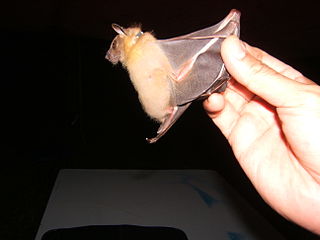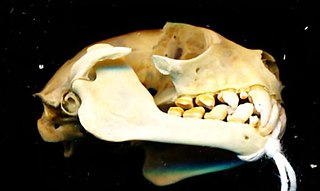
Cynopterus is a genus of megabats. The cynopterine section is represented by 11 genera, five of which occur in Malaysia, namely, Chironax, Balionycteris, Penthetor, Dyacopterus, and Cynopterus. About 30 names for Cynopterus species have been proposed, but only 16 are taxonomically valid forms.

The eastern or Queensland tube-nosed bat is a megabat in the family Pteropodidae that lives in north-eastern Australia. N. robinsoni is one of the few species of megabat that roosts solitarily. They get their common name from their raised tubular nostrils which are unlike those of most other species in the family. They are a deep brown with gray heads and sparse yellow spotting.

The broad-striped tube-nosed fruit bat, also known as the greater tube-nosed bat is a species of megabat in the genus Nyctimene. It is found in West Papua, Indonesia, Papua New Guinea, and central Philippines. In 1912, Andersen distinguished it by its very broad dorsal stripe on the center of its back. Although this species is believed to exist at low densities, the IUCN estimates its population to be stable and has no major threats to its continued existence. The IUCN classifies Nyctimene celaenoThomas, 1922 as a synonym of this species, however as of 2013 the ITIS lists it as a separate species.

The common tube-nosed fruit bat is a species of megabat in the family Pteropodidae. It is found at islands north of Australia, and in Indonesia, Papua New Guinea, the Philippines and the Solomon Islands.

The mountain tube-nosed fruit bat is a species of megabat in the family Pteropodidae. It is endemic to New Guinea island and to New Britain Island.

The round-eared tube-nosed fruit bat is a species of bat in the family Pteropodidae. It is possibly conspecific with Nyctimene certans, although the taxonomy remains unresolved. The possible synonymy of the species was investigated by Randolph L. Peterson in 1991, finding the species split into two distinct groups based on morphology. It is found in West Papua and Mansuar Island in Indonesia.

The island tube-nosed fruit bat is a species of bat in the family Pteropodidae. It is found in Papua New Guinea and the Solomon islands.

The Malaita tube-nosed fruit bat is a species of bat in the family Pteropodidae. It is endemic only to the islands of Malaita and Makira in the Solomon Islands. The species occurs in primary tropical moist forest.

The demonic tube-nosed fruit bat is a species of bat in the family Pteropodidae. It is endemic to Papua New Guinea. The holotype specimen was collected in 1979 on New Ireland, in the Bismarck Archipelago. It was described as a new species in 1983. The range of the species may extend to other islands, however the extent of the range is not presently known.

The Philippine tube-nosed fruit bat locally known in Tagalog as Bayakan is a species of bat in the family Pteropodidae. It is endemic to the Philippines and known from the islands of Cebu, Negros and Sibuyan. It occurs in and near primary and secondary subtropical or tropical dry forests. It is often found near water. The species is named for Dioscoro S. Rabor who, with several others, first collected the species.

The Umboi tube-nosed fruit bat is a species of megabat in the family Pteropodidae. It is found in Papua New Guinea and the Solomon Islands.

The lesser tube-nosed fruit bat or unstriped tube-nosed bat is a species of megabat in the family Pteropodidae found in West Papua, Indonesia and Papua New Guinea.

The Bougainville monkey-faced bat or Bougainville flying monkey is a megabat endemic to Bougainville Island of Papua New Guinea and Choiseul Island of the Solomon Islands in Melanesia. It inhabits mature forests in upland areas, within the Autonomous Region of Bougainville and Bougouriba Province.

The minute fruit bat is a species of megabat within the family Pteropodidae. It is found in Sumatra, Java, Borneo and Sulawesi. C. minutus is a smaller species that lives in rainforests. Continuous bimodal polyoestry has seasonal reproduction. The females of the species reproduce in synchrony, giving birth to offspring 5–7 months apart throughout two separate seasons. Postpartum oestrus occurs after each parturition. In C. minutus, both sexes reach sexual maturity at around 7 months, and females give birth for the first time at around 12 months. Females start having children not long after reaching sexual maturity, and they effectively continue having children indefinitely. Relative to other fruit bats, C. minutus have high rates of reproduction.

Nyctimene is a genus of bats in the Pteropodidae family. Commonly known as tube-nosed fruit bats, they are found in the central Philippines, eastern Indonesia, Papua New Guinea and the north-east coast of Australia.

Keast's tube-nosed fruit bat is a species of megabat in the family Pteropodidae found in Babar, Tanimbar, and the Kai Islands. It was named after Colin Keast.

The steadfast tube-nosed fruit bat is a species of megabat in the family Pteropodidae found in West Papua, Indonesia, and Papua New Guinea.
Paranyctimene is a genus of bats in the family Pteropodidae. They are distributed in Indonesia

















